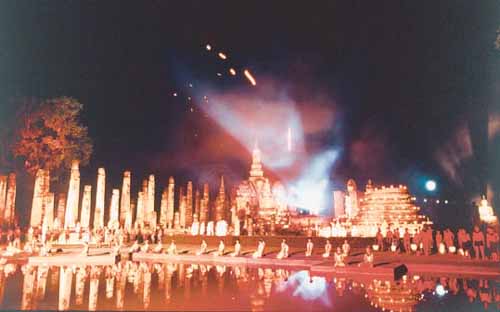Loy Krathong: Festive air for a night of worship

-
Each year the Sukhothai historical park is illuminated for the Loy Krathong festival, one of the strongest cultural links between Thais and their ancestors.
Nov 22, 1999: THIS evening, as the Thai people go to the nearby rivers, khlongs or ponds to float their lotus-shaped vessels made of banana leaves, they will be evoking the spirit of the sacred past, with a blessing of a full moon.
Of all the Thai festivals, Loy Krathong is perhaps one of the most ritualistic and colourful events, rich in religious and spiritual expression. A krathong normally comes with a candle, three-joss-sticks and some flowers. Floating the krathong down the river during the high tide, and after the rainy season is over, not only signifies the attempt to purge evil or bad luck, but also represents an act of worshipping the Goddess of the water.
Therein lies the influence of Brahminism. Brahmin rites cannot be separated from the traditional religious practices of the Thais. But ancient Thai beliefs and folklore also hold that there are higher spirits residing everywhere, in the rivers, the trees and the mountains. There are virtually no places on earth that are not, or have not been, occupied by ghosts or by gods. You are supposed to act with reservation and not to speak out loud when you are in a forest because you do not want to disturb the spirits. But in Western thought, a forest is nothing but a wilderness for man to conquer.
For Bt3,800 a ticket at the Shangri-la Hotel, you can observe the delights of fireworks above the Chao Phraya River while having your favourite wine and food. Other Bangkok hotels, with an eye for the dollar, also go at top gear with their Loy Krathong gimmicks. This is an idle, if not rather expensive, way to let the Loy Krathong Day slip by without philosophising or without the trouble fighting the crowds on the riverbanks.
Nowhere in Thailand is the Loy Krathong Festival held with more fanfare than at Sukhothai, one of the ancient capitals that lies about 450 kilometres north of Bangkok. Despite its past grandeur, and its Utopian characteristics, Sukhothai's existence comes to the fore only once a year, at the time of Loy Krathong. For most of the year Sukhothai is far from the Thai consciousness, like the ruins of its past that are forever buried under layers of the earth.
Reviving Sukhothai can only be done necessarily by popularising it, with modern lights and sounds against the background of its decaying structures. But as the young girls, clad in exquisite Thai costumes, prepare to float their krathongs into the pond of the Sukhothai historical park in front of the thousands of visitors, they almost unconsciously might have formed an elusive image of the grandiose Noppamas in their imaginations.
What Venus is to beauty for the ancient Greeks, Noppamas is beauty for Thais. And one way of popularising Noppamas is to immortalise her through the Noppamas Beauty Queen Contest, held not only in Sukhothai but elsewhere throughout the country.
Legend has it that Noppamas, a beautiful lady of exceptional wit and charm, was the first to have devised the krathong in the 13th century. She served in the court of King Lithai, the grandson of King Ramkhamhaeng The Great. A favourite of the king, Noppamas was said to have raised court mannerisms and practices to a high order. The krathong she floated created a lasting tradition that is still observed today, though with different imageries.
Now Loy Krathong is firmly connected with the worldly desires for material gains. Young Thai couples also find the festival auspicious enough to bind their love together. You will know a Thai girl's boyfriend by waiting to see with whom she goes to float the krathong with. Little do the young couples realise, however, that once they float the krathong, which is supposed to hold their spirits together, they let go their destiny into the realm of the unknown.
While most Thais know Noppamas by associating her with the Loy Krathong Festival, few have bothered to go back to read King Lithai's Buddhist to gain a proper frame of mind.
While his grandfather King Ramkhamhaeng was held as the inventor of the Thai written characters, King Lithai wrote Trai Phum Phra Ruang or ''Sermon on the Three Worlds''. This masterpiece was recognised as a Thai version of the Divine Comedy, ranked in the same class as Dante's.
King Lithai's ''Three Worlds'' do not represent the earthly, the infernal or the heavenly spheres, but account for the three Buddhist forms of existence of the sentient world. In this religious universe, there is the world of kama-loka, or the world of the five senses; the world of rupa-loka, or the corporeal world of the 16 celestial grades; and the world of arupa-loka, or the incorporeal world where the five senses cease to function. This treatise formed a doctrinal basis for King Lithai to lead his followers to redemption. Ancient Thais were given the vision of the various cosmic realms and their inhabitants, some of whom were confined to eternal damnations if they could not break away from their sins.
Floating the krathong with King Lithai -- not Noppamas -- in your heart will get you closer to Dharmma. A shocking reality is now emerging that in spite of her immortality, Noppamas might not exist at all.
Whether she is a historical person or a fictional character is a subject of controversial debate in the academic circle. But let the academics carry on their debate. Noppamas will continue to exist, for in Thailand histories and legends are mixed so intensely like moulding gold into a pagoda that the facts lie in the realm of introspection.
Even the significance of Sukhothai as the first formal capital of Thailand has also been disputed bitterly among the historians. For generations, Thais have been taught that Sukhothai was Thailand's first formal kingdom before it was defeated by Ayudhya. Then we have Thon Buri and Bangkok. All of which cover a span of more than 700 years. New suggestions have attempted to paint Sukhothai as simply one of the several kingdoms or muangs, which were scattering throughout this part of the world and vying for political and military predominance at the time.
To deny Sukhothai is one thing, but to delete Noppamas from the Thai consciousness amounts to daylight robbery of Loy Krathong. The young girls who dance in front of the remnants of the Sukhothai look as if they were trying to establish a connection with the past through Noppamas, the person they can only imagine or dream of. And these Sukhothai dancers are but the descendants of the semi-devine and radius beings, who at the beginning of time, came down to this world and were lured by the temptations of the fragrance of the earth. Once they tasted the earth, they at once became walking mortals. In this classical Buddhist doctrine, mankind was created and reincarnated in the unending cycle of suffering, until enlightenment is attained.
For almost three years, Thais have come to appreciate the world ''float'' even more. After the float of the Thai baht in July 1997, its value has been bumping up and down like the fate of the krathong trying to negotiate the treacherous high waters. The arrival of the Loy Krathong Festival once again reinforces the universality of Buddhism. It completes the cycle -- that the certain has become the uncertain and the uncertain has become the certain.
BY THANONG KHANTHONG















